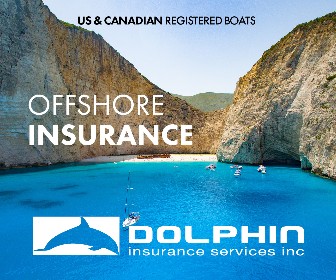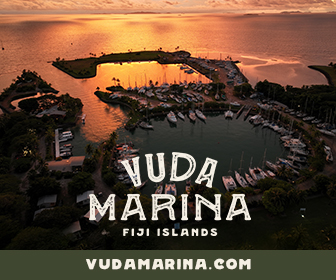After the Sails are Furled: Part 2 – Looking Back on 25 Years of Cruising
Retired New Zealand cruiser John Manning has written three articles for Noonsite about his cruising life around the South Pacific islands and what it meant for him to hang up his sea boots. In Part One he reminisces on his last offshore voyage to Fiji. In this article, Part Two, he recounts some of the highs, lows and lessons learnt while cruising between Fiji, Tonga, New Caledonia and New Zealand over the years.
Published 3 weeks ago
Long Distance Cruising Strategy – why I failed
The most important factor in long distance sailing is your partner. Do they have the same goals? Are they committed to the plan. My wife is not a sailor. She comes on trips because she likes a bit of adventure and wants to support me. On offshore passages she suffers and it shows. Sea-sickness is a persistent problem.
In 2011 and 2015 Ann was the reason we sailed back to New Zealand when we did. In 2024 it was both of us. My overall feeling about the 2015 and 2024 trips is disappointment. I am disappointed I did not complete what I started. This section of my story identifies what I did wrong. A different strategy would have allowed me to do much more.


Strategy One
If your wife/partner is not a sailor get her/him to fly the offshore passages. Crew are not hard to find.
One of the obvious things you see in modern long term cruisers is that they travel home regularly. It is quite normal for today’s European or American cruiser to sail for less than six months of each year. By that I do not mean they are sailing the yacht from one place to another. I mean they are on their yacht for less than six months each year. The rest of the year they are back at home, on holiday if you like. That is the key to sustaining a long cruising plan. Going out and staying out for years at a time has always been too much for Ann and now it is too much for me as well.
There is a poster in the visitors lounge at Opua Marina which has a picture of the South Pacific Ocean from Panama to Australia with the very wise words, “its too much for one season”. Northern hemisphere sailors are now spending two to six years just doing the South Pacific Islands. Some move on to South East Asia for several more years. Each “year” is actually four to eight months. This is the way to plan a long cruise. The demands of modern life make it very difficult to do it any other way.
The key to this is leaving your yacht behind when you return home. That takes a lot of planning. You need to have a place to stay when you get home, not just for a week, but for several months. You need to organise a safe location to leave your yacht. You need to budget time and money for getting the yacht ready for another season when you return to it. You need to know the time limits for leaving a yacht in a foreign country.
The Allure of Fiji
There is another problem with my cruising plans – Fiji. In my opinion Fiji is the best cruising ground in the world. I love the place. I would move there if my wife would agree (she says its too hot!). So a big problem for me is leaving to go somewhere else. There just does not seem to be a good reason to go anywhere else. Generally we have left only when our visas were expiring. I should have planned my trips to end in Fiji.
Somewhere deep inside I have a need to sail. Maybe I am a gypsy at heart. Maybe it’s inherited from my great Grandfather, a Scottish ship owner, who traded on the clipper ship route. Now that was real adventure. My great Grandparents lived on the ship and my great Grandmother sailed as well, circumnavigating in the 1860s. Her first child was born while rounding the Cape of Good Hope.
So, for whatever reason I have always grabbed any opportunity to sail when it was beyond a harbour. Coastal deliveries were the start, on anything from 30ft yachts to 250ft fishing vessels. My work in ship repair gave me the contacts for this. On my earlier yacht deliveries I became convinced that I was being asked to be crew in order for repair work to be done at no cost. I regularly fixed auto-pilots, steering systems, as well as hydraulic and plumbing problems at the start of the voyages. It did not matter. When I was sailing I was happy. Sailing offshore was at another level.
My first trip to Fiji was in 2003. I flew from Wellington to Nandi, then caught a taxi to Vuda Marina. I walked around the bowl to join the yacht Kahukura 11. I was delivery crew for a voyage back to Wellington. My expectation was that I would arrive, unpack and the following day go to customs in Lautoka and leave Fiji bound for Wellington. Phil, the skipper, had different plans.
Phil had been in Fiji for two months repairing a broken rudder and then testing that by sailing the Yasawa Islands. Also we had to wait for an All Blacks test match which was going to be shown on the screens at the adjacent First Landing Resort. In those days there was a back gate which joined Vuda Marina to the resort. The test match was a first lesson in Fijian culture.
We went to First Landing restaurant, had dinner and then sat down to watch the match. All Blacks versus Fiji. In the room were the four of us and a group of Fijians who worked at the resort. Unsurprisingly the All Blacks won, by a good margin. The Fijians were cheering this throughout the game.
At the end of the test I walked over to the Fijians and asked why they cheered so much when an All Blacks was scoring all the points. They told me that was nonsense, a Fijian scored nearly all the points. Joe Rokocoko was on the wing for the All Blacks and scored four tries. Joe was from a local village just north of Lautoka. There are different ways of looking at things.
About a week after I arrived we finally went to Lautoka Customs Office and filled out all the various forms required for yacht clearance. The processes were fairly casual but very paper intensive. The yacht stayed at Vuda Marina and we went by taxi to Customs on the Lautoka Wharf. On returning to the yacht I thought “right we are off”. Phil, the skipper, had different plans.
Waiting for the Right Weather
The following day we left Vuda Marina and made our way, all of 10 or so miles, to Musket Cove. I remember getting off the yacht, onto the pier and being amazed by the scenic beauty of the bay, the causeway, the island bar, the palm trees and the sand. One of my first thoughts was, I will have to sail back here with Ann (my wife). As I said before, things were more casual then. We were supposed to be outside the 12 mile limit within 24 hours of getting clearance to leave. We left six days later. Phil kept saying the weather wasn’t right.
Phil was correct about the weather. When we finally left it wasn’t right. Too much southerly and not enough easterly to sail to NZ. But that is another story.
I had made my mind up to sail back to Fiji. In 2007 I sailed again to Fiji, as crew on Kiss 11. It was not until 2011 that I sailed my own yacht to Fiji. We had intended to go to Tonga first, but wind and Tony’s (one of our crew) course keeping meant making Fiji was more realistic. So we stayed for three months in Fiji. It was exciting to explore a new country and we sailed through all the Yasawa Islands and then onto Vanua Levu and Taveuni. At this point we found major map errors in our C-Map based systems and stopped short of going to the Lau Islands.
2011 was a very still year in Fiji. We motored everywhere because there simply wasn’t any wind to sail with. This also meant that the temperature was hot. Most of April to June was above 30 C. In July it cooled slightly to about 28 C. The wind was strong on two nights during our three month stay and at no times other than that. We were able to travel wherever we pleased and anchor without concern, even close to reefs.
Throughout our stay, Vuda Marina was our base. It was the home we went to when tired. It was where we welcomed visitors who were joining the yacht for days or weeks at a time. We could get a hot shower and restaurant meals and a secure yacht berth. It was relaxation time. And then as now it was full of yachties from Europe and America. People who were interesting to talk to and had many tales of adventurous sailing.
Learning about Fijian Culture
We had our own adventures in the smaller offshore islands. Learning about sevusevu and Fijian culture. Fixing engines and generators was a common part of the experience. Seeing European and American sailors making appalling mistakes in behaviour and the quiet way the Fijians reacted to that. At one village we met a European yacht crew who did everything wrong. They began by anchoring close to the shore and immediately stripped naked and swam in the bay. They then went ashore, the women in very small bikinis, the men just wearing shorts. When they got back to their yacht they asked us over for a drink and told us of the wonderful reception they got at the village. The villagers sold them souvenirs and offered them a Fijian banquet for only $20 each (this was 2011). These were the same villagers who had been feeding us for free for over three days because I had done a minor repair on an outboard motor.
Staying in one place for several days proved a very good way of making contact with Fijians and not just other sailors. These are the memories that have stayed with me.
Back to New Zealand
Home and work meant we had to return to NZ so we sailed back on a schedule. One of the worst things you can do sailing offshore is sail to a schedule. We had returned to Vuda Marina to await a weather window for NZ. Unless you wait until October, weather windows sailing south from Fiji are short. Two to four days is not time to make NZ. In mid August a persistent low pressure system between New Caledonia and Queensland looked stalled, so we departed. Once we started to move so did the low. We stopped to let it past and it stopped, we started again and it moved again. This was repeated and then it closed in on us.
Six metres seas are not so bad. It was surprising that the wind was only 25 – 40 kts, to generate those seas. It’s the double height waves that were the more frightening thing. We were in those conditions for 48 – 60 hours, so had plenty of time to look around. In the distance we regularly saw the double height waves. Fortunately when we had to go over one it was daylight. It is still a disturbing sight to be in a 12m catamaran looking back at a trough 1.5 to 2 meters behind the yacht and looking up and forward to growling white water 1.5 to 2 meters in front of the yacht. Fortunately we were moving upwind but that required engines to keep the speed above 5.5 knots.
I learnt two things from that. Firstly I do not want to sail through another storm and secondly the decision to hove to and wait for a storm to pass is the best one you can make when caught in bad weather. What I did not learn was not to sail offshore on a schedule, I did it again last year.
We did eventually hove to in that 2011 storm and the best way I can describe it is to say it was like flicking a switch and turning the weather off. In that calm moment I took the time to check over the yacht. There was a tear about 2 ft long in the mainsail. We carried on with about one third of our main. The rest reefed away. Engines still on because of head winds. Once back in Opua I checked how well we had done regarding fuel use. Main tanks empty, Day tank 25 litres. We had started with just under 600 litres of fuel. On the way north to Fiji we started with 850 litres and used 35 for the whole voyage.
Tonga this time
Changes at work allowed us to sail away again in 2015. This time we went to Tonga first, where we were disappointed with Nuku Alofa and then by-passed the Hapai group before spending three weeks in Neiafu. The best thing about Neiafu was the Mango Cafe.
The Tongan officials included a proportion who would bend rules and do that bit extra as long as it was paid for in cash. ie. They took bribes.
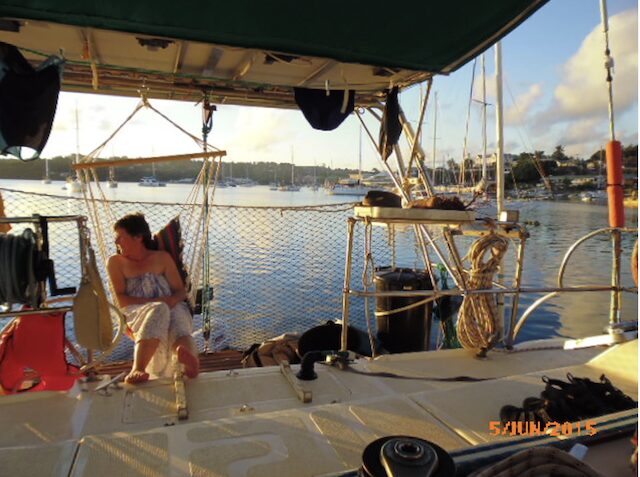

Describing Nuku Alofa
We arrived in Tonga at Nuku Alofa. The procedure was to call harbour control and seek permission to enter the small enclosed inner harbour area, tie up to the entry dock and wait on customs and immigration. We loitered about the harbour entrance for nearly six hours, repeatedly calling harbour control, no response. We finally got a reply and were allowed to enter the harbour but because the entry dock was occupied we were directed to the embankment where the tugs normally berthed.
This should have allowed quick processing by customs and immigration because their offices where about 20 metres from our yacht. It took two days to complete our entry process. The customs and immigration staff could not find us because we were not at the entry dock. They were looking past our yacht, flying its yellow Q flag and seeing an empty entry dock.
Another amusing event occurred on day two. On my way back from the nearest ATM machine, as I walked back to the yacht a tall slim and very attractive Tongan women about 20 years old sidled up to my 57 year old side and asked where I was from. After I told her I was a New Zealander she asked if I would like her to show me around the various ‘night clubs’ and bars in Nuku Alofa that evening. I said that I would have to ask my wife. At the mention of the word wife, she immediately changed to offering to do laundry or sell us drinking water, which left me wondering what her initial plans had been.


Tropical Rain in Tonga
We settled into a short stay at Nuku Alofa. Our plans to stay there shortened every day. There had been a drought for several months and the town was short of water. However after three days it rained. It rained the way only tropical locations can rain. The streets were running with water. The drains were full and overflowing. Despite the rain being needed the result was anything but pleasant. The drains and gutters overflowed and months of litter came bubbling out and was distributed across the roads. Paper, plastics and other unidentifiable things.
Next day the rats came up out of the drains. They came to get their rubbish and take it back into the drains. Not such a bad thing when you realised that no one else was cleaning up, but that number of rats wandering the streets was unsettling. We left the following day.
We motored past Pangai Motou and decided it was too close to Nuku Alofa so went on an overnight sail to the Vavau Islands. When we reached Neiafu the weather changed. For the next four months in Vavua, Fiji and New Caledonia we experience strong and relatively cold winds. They were predominantly south east trades, usually 20 to 25 knots.
After three weeks in the Vavau group using Neiafu as a base, we left Tonga with no regrets. Well one regret, that was leaving the Mango Cafe behind. On our last night in Tonga we had dinner at the cafe and were surprised to find a Tongan song and dance demonstration. It was one of those magic moments you can have when travelling. Unexpected, very entertaining and I wish I could see it all again. The cafe owner had got the local school to send its pupils along to do the performance. They were all teenagers. All having a really good time. Everyone smiling and laughing as they performed the dances and songs. When at the end they asked for donations for the school I did not have enough money on me to pay what I thought it was worth.
Tonga to Fiji
We sailed on to Fiji the next day. Waves quite high at three metres but wind (finally a tailwind) dropping from 20 down to still by the time we sailed through the Lau Group. We entered Fiji at Savusavu. Jian who joined us in Neiafu wanted to go to Dolphin Divers at Viani Bay. We wanted to go back to Viani Bay so we set off a couple of days later. We got out of Savusavu Bay and turned south east past the light,into a strong south east wind and waves of 1.5 meters. After an hour of going nowhere we turned and went to Namena Island. From there it was back to Savusavu two days later. The wind had not changed. We dropped Jian off and he caught a bus/boat to Dolphin Divers. Jian told us later that the delay getting to Viani Bay was very positive for him. He got there a week later than expected and in the dive group he was placed with, there was a young woman who is now his wife. Travelling connects you to wonderful things.
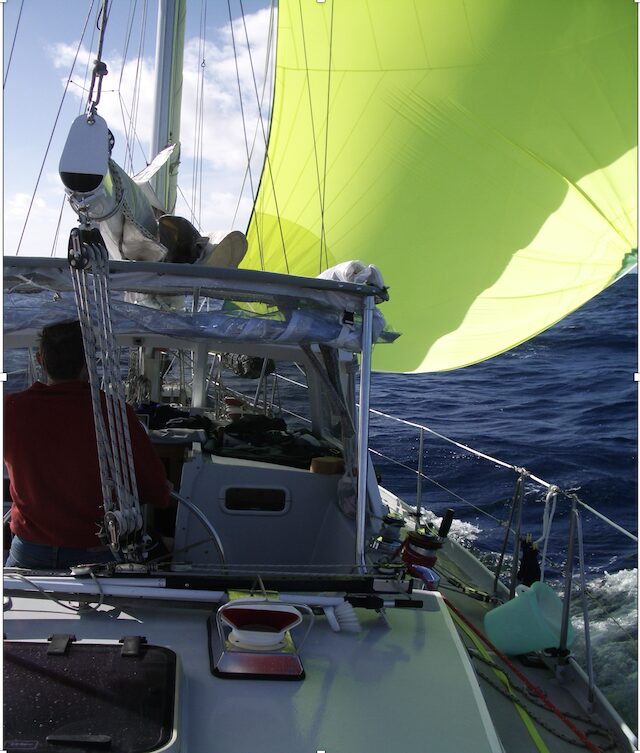

Home Away from Home
Ann and I then sailed on to Viti Levu. We went back to Vuda Marina, our base for travelling between the Yasawas, Musket Cove and Denarau. We had three groups join the yacht for some Fiji time. Vuda was the focal point for showing them the little of Fiji which time allowed.
Vuda Marina was our home away from home. It gave us that sense of knowing where we were. The Boat Shed restaurant was a big part of that. If anyone asks me where the best restaurant in the world is, I say without hesitation, the Boat Shed at Vuda Marina. I have had better food in other places but nothing compares with that location. And there are so many reasons for that.
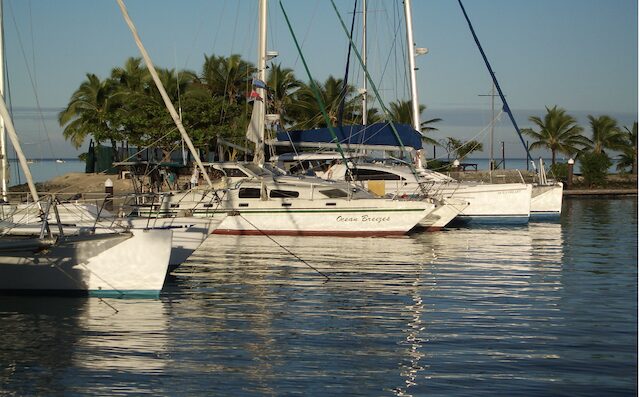

New Caledonia Next
In early September we sailed to Noumea. We were hoping to see some of New Caledonia but the winds were still very strong and we found Noumea entertaining. The highlight was another unexpected performance. We were in Noumea for the Festival of the Flowers. It seemed that the whole of Noumea (the Europeans at least) was on parade.
Noumea had it dark side. Throughout the town and especially near the waterfront there were groups of Kanaks sleeping on the streets and looking anything but friendly. At night they would beg for food, not money. At first when I was asked to buy someone a hamburger I did not understand. I gave him the price and told him to buy it himself. What I did not realise, was that money was no use to him. The shop would not serve him, would not accept his money. That shop was just a roadside caravan selling hamburgers and hotdogs. 2024 saw the result of that prejudice and the problem is not going away.
We had planned to sail onto Australia and maybe the following year to South East Asia. Family matters brought that all to an end and we sailed home instead. An October voyage south. Good sailing, pleasant weather, seas not above 2.5 metres wind not above 25 knots, nearly all from the west.
I planned another trip for 2020. But a pandemic happened instead.
Looking back on the last 25 years there are several things I have learned. Most of all, yachts and sailing, especially offshore sailing, have made me a much poorer man, financially. Looking back I also know I never finished the plans I started. If I had been able to do more I would now be much poorer and much happier.
But I am not dead yet and I still own a yacht, so there is always hope.
John Manning
Kapiti, New Zealand.
…………………………………
Read Part One of John’s Essay:
In Part Three of his essay to be published next month, John recounts some of the things he has learned and seen over his many years of life as a cruising sailor – from changes in yachts and navigation, to the sailors themselves.
…………………………………
© 2025 Noonsite. This content was edited by Noonsite. Do not reproduce without permission. All rights reserved.
The opinions expressed in this article are the author’s own and do not reflect the view of Noonsite.com or World Cruising Club.
If you have found this information useful, become a paid member to enjoy unlimited use of Noonsite plus many other perks. Your membership fees really help our small, dedicated team keep country information up-to-date in support of cruisers worldwide. Find out more about Noonsite Membership levels and benefits here.
Subscribe to our FREE monthly newsletter: https://www.noonsite.com/newsletter/
Related to following destinations: Fiji, Lautoka (Vuda Point Marina), Mamanucas and Yasawas, Musket Cove, Neiafu (Vava'u), Nuku'alofa (Tongatapu), Port Denarau, Savusavu, Tonga, Vanua Levu, Viti Levu
Related to the following Cruising Resources: Cruising Information, Pacific Ocean South, Planning and Preparation, Routing





